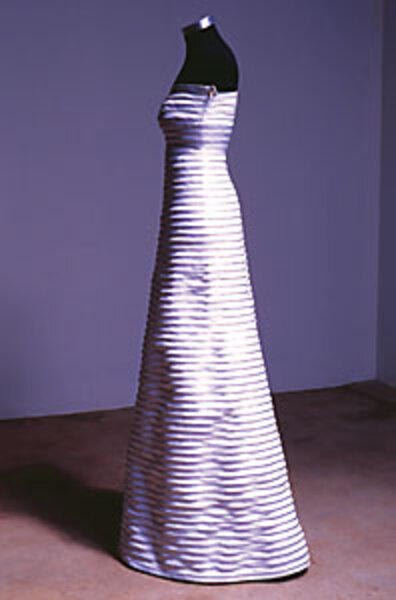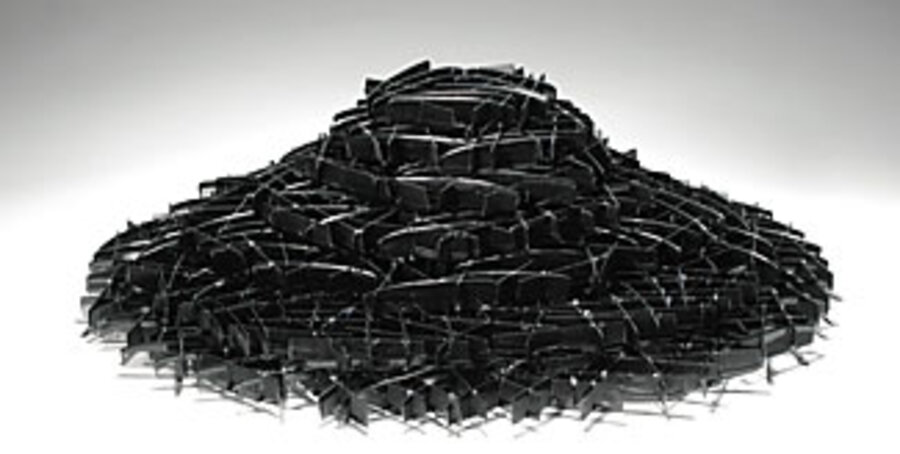Co-opting consumerism
Loading...
Contemporary artists could show the writer of Ecclesiastes a thing or two. They directly challenge the oft-quoted lament, "There's nothing new under the sun" by constructing eloquent and unexpected art out of ordinary, mass-produced objects such as pocket combs and plastic bottles.
Artists have incorporated recycled materials such as glass, metal, and plastic for decades. The difference today is a focus on the use of brand-new, straight-off-the-shelf consumer goods, says Steven Skov Holt, who, along with Mara Holt Skov, his wife, organized the exhibition "Manufractured: The Conspicuous Transformation of Everyday Objects" at the Museum of Contemporary Craft in Portland, Ore.
The 15 artists in the exhibition manipulate consumer goods such as street maps, spools of thread, toy soldiers, and cellophane tape. They cut, stack, tie, fold, stitch, and mold the materials into new forms, often using painstaking handcrafting techniques. Their process finds parallels in the world of rap and hip-hop music, in which street noises and samples of other music are captured and remastered to create a unique sound.
Steven, who uses the example of hip-hop music in his introduction to the exhibition catalog, doesn't mind people making a link between the creative process of rap and that of contemporary craft. "Craft should be so lucky" as to enjoy the enormous popularity of hip-hop, he says with a laugh.
The couple teaches design at the California College of the Arts in San Francisco. Steven's background centers on industrial design and Mara's involves art history. They were cocurators for a previous exhibition on "Blobjects," about items designed to mimic the rounded, human-friendly shapes found in biology.
Here they make a compelling case for a new art movement taking shape, born out of a necessity that many artists feel to both co-opt the trappings of consumerism and to comment on the culture at large. The couple has observed a blurring of boundaries among the art disciplines and the emergence of a working style that borrows heavily from the traditions of craft and handwork, but welds it firmly to modern-day technology and concerns. Steven coined the term "manufractured" to describe the breaking apart that mass-produced objects undergo during their transformation from banal products to extraordinary creations.
The resulting art can be viewed on several levels: as simply beautiful objects, as social commentary, and as inspiration for future product design. One could envision Mitra Fabian's elegant, translucent vessels from her 2005 "Proliferation Series," made by layering strips of cellophane tape, as the prototype for a new kind of portable lighting, for example.
These artists, by living in an industrialized society that churns out billions of perfectly uniform widgets daily, can also become driven to emulate that machinelike perfection in their work. Some of them use tools like computers, but others attempt to reproduce that sense of uniformity with their own hands.
Sonya Clark stacks thousands of black plastic pocket combs into curving sculptures or sews them together into wall hangings. She likens the ritual process of combining the combs to meditation: "When the body is doing a repetitive task, the mind can take off in other ways; it can dream," she says. During this time, she often conceives her next project.
Artist Livia Marin takes this notion of painstaking process even further. For the 2007 installation "Ficciones de un uso II" she remolded 2,200 lipsticks into shapes ranging from knobs and spires to drops and pyramids, then displayed them in their chrome cases.
Artists choose a particular material because it speaks to them. Clark associated combs with childhood, the times she sat while her mother or another female relative combed her "unruly" hair. She also had an image from the 1960s of the guy with his Brylcreemed hair slicked back into a ducktail, comb stowed in the back pocket of his jeans. "Never a hair out of place," says Clark, in contrast to her own "gravity-defying" hair.
In addition to the tactile nature of these mass-produced goods – recall the satisfying feeling of rubbing a comb's teeth, or the creamy, drenching sensation of lipstick – artists choose them because they're readily available and relatively cheap. (Although Clark says with the rising price of petroleum-based products, she wishes combs were cheaper.)
By sorting and organizing objects that otherwise might overwhelm us by their sheer number, artists achieve mastery over their environment. How many times have we gone shopping for a simple household item, only to be frustrated by the endless options and choices? By co-opting the physical object, artists begin to tame the beast of rampant materialism.
"One way to understand and embrace these objects is to order and control them," Steven says. As an audience, we "outsource" our organizing to these artists and hopefully come away less cowed and more empowered.
While the underlying subject matter may be serious, the art itself is often disarmingly witty. Many pieces are the visual equivalent of a wink and nudge. One can almost hear artist Cat Chow's 1999 "Zipper Dress" saying seductively, "Can you see that I'm a strapless gown made entirely from one continuous coil of zipper?" Constantin and Laurene Leon Boym's towering sculptures might even be heard to whisper, "Come closer and see that my components are stacked china plates, teacups, and saucers."
While some of these artists do reuse china cups, bottle caps, or car parts, the art featured in "Manufractured" goes beyond recycling. The artists aren't so much pulling used material out of the waste stream as they are wading into the headwaters. Like Sonya Clark, who orders case of combs from the manufacturer, these artists are tapping the uniformity and ubiquity of everyday items.
Thinking further about the exhibition, one can see a circular pattern emerge. These goods have gone through an initial product design in the manufacturing process, an artist responds to the design and remakes or appropriates the item, creating a work of art that speaks to that product's image and status in our culture. At the end, the artist places his or her own mark, or brand, on the finished product. We, as consumers of both goods and art, are then invited to add our own associations, contributing to the ongoing dialogue that art encourages.
• 'Manufractured' will be at the Museum of Contemporary Craft in Portland, Ore., through Jan. 4, 2009 (www.museumofcontemporary craft.org). The accompanying book can be preordered from Chronicle Books at www.chroni clebooks.com.







